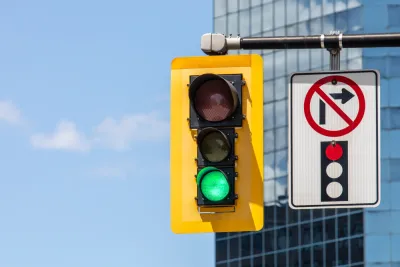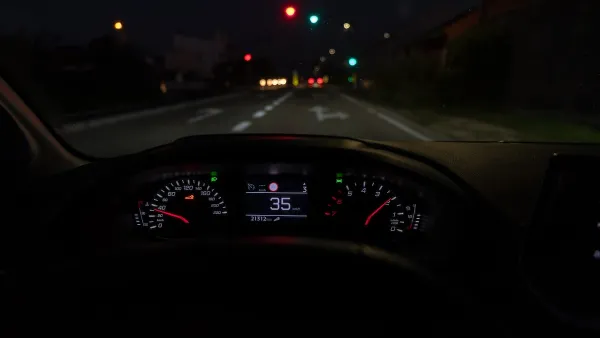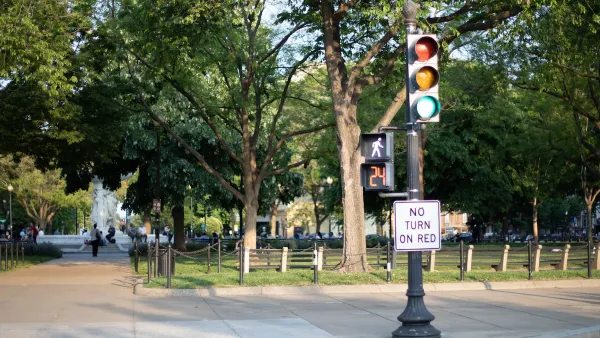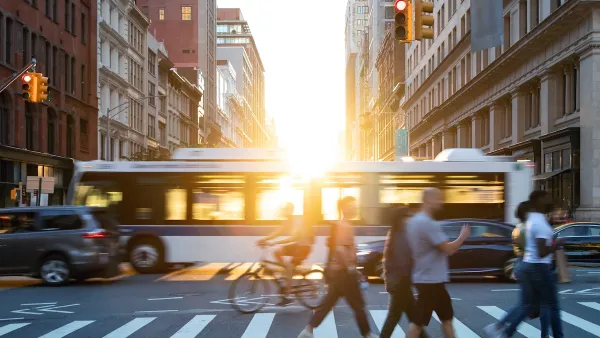Born out of the oil crisis of the 1970s, the practice of turning right on red lights is a uniquely American—and uniquely dangerous—custom.

Most American drivers don’t think twice about making a right turn on a red light (RTOR). For decades, it’s been the status quo in many cities. But as Abigail Weinberg explains in an illuminating Slate article, the habit is relatively new and, to many experts, obsolete and dangerous. According to Weinberg, “The data on right-turn-on-red crashes might be scarce, but the existing studies suggest that these types of collisions—while rare—frequently involve a pedestrian or cyclist.”
The practice was born out of the 1970s oil crisis, when the government sought to reduce emissions by minimizing idling at red lights. “A provision of the 1975 Energy Policy and Conservation Act said that, in order for states to receive federal assistance for mandated conservation programs, they had to enact ‘a traffic law or regulation which, to the maximum extent practicable consistent with safety, permits the operator of a motor vehicle to turn such vehicle right at a red stop light after stopping.’”
However, the policy has never been proven to significantly reduce emissions or idling time. “Take into account the growing number of hybrid and electric cars, and RTOR makes even less sense.” Meanwhile, electric vehicles have the potential to increase RTOR crashes due to their quicker acceleration.
Quoting transportation engineer Bill Schultheiss, Weinberg concludes that making right turns on red illegal, while a “minor enough inconvenience” for drivers, could be “a baby step in creating an urban environment that is more supportive of walking, bicycling, and transit.”
Today, more cities are moving to ban RTOR. New York City has a ban, and Washington, D.C. could soon follow, if legislation passed by the district’s council is approved by the mayor and Congress. Ann Arbor, which delayed its vote on the issue earlier this year, voted to ban RTOR at 50 intersections in its downtown.
FULL STORY: The Surprising History—and Deadly Consequences—of Right Turn on Red

National Parks Layoffs Will Cause Communities to Lose Billions
Thousands of essential park workers were laid off this week, just before the busy spring break season.

Retro-silient?: America’s First “Eco-burb,” The Woodlands Turns 50
A master-planned community north of Houston offers lessons on green infrastructure and resilient design, but falls short of its founder’s lofty affordability and walkability goals.

Delivering for America Plan Will Downgrade Mail Service in at Least 49.5 Percent of Zip Codes
Republican and Democrat lawmakers criticize the plan for its disproportionate negative impact on rural communities.

Test News Post 1
This is a summary

Test News Headline 46
Test for the image on the front page.

Balancing Bombs and Butterflies: How the National Guard Protects a Rare Species
The National Guard at Fort Indiantown Gap uses GIS technology and land management strategies to balance military training with conservation efforts, ensuring the survival of the rare eastern regal fritillary butterfly.
Urban Design for Planners 1: Software Tools
This six-course series explores essential urban design concepts using open source software and equips planners with the tools they need to participate fully in the urban design process.
Planning for Universal Design
Learn the tools for implementing Universal Design in planning regulations.
EMC Planning Group, Inc.
Planetizen
Planetizen
Mpact (formerly Rail~Volution)
Great Falls Development Authority, Inc.
HUDs Office of Policy Development and Research
NYU Wagner Graduate School of Public Service





























